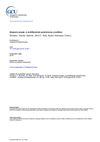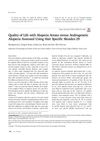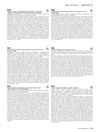TLDR Severe pediatric alopecia areata worsens quality of life for patients and families.
The study investigated the impact of pediatric alopecia areata (AA) on the quality of life (QoL) of patients and their family members through a nationwide multicenter questionnaire. It found that the severity of AA was inversely related to the QoL of both patients and their families, meaning that as the severity of AA increased, the QoL decreased. Additionally, the burden on families increased with the severity of the condition. The study emphasized the importance for physicians to recognize these effects and to offer suitable interventions to support both patients and their families.
 148 citations
,
December 2018 in “Journal of autoimmunity”
148 citations
,
December 2018 in “Journal of autoimmunity” Alopecia areata is an autoimmune disease causing patchy hair loss, often with other autoimmune disorders, but its exact causes are unknown.
 13 citations
,
January 2018 in “Annals of Dermatology”
13 citations
,
January 2018 in “Annals of Dermatology” Alopecia areata and androgenetic alopecia affect quality of life similarly.
63 citations
,
January 2017 in “Annals of Dermatology” The study analyzed factors associated with the severity of alopecia areata in Korean patients, representing the largest case analysis of its kind at the time. It highlighted the need for further research into clinical profiles stratified by disease severity to better understand the condition.
 25 citations
,
December 2015 in “Journal of the European Academy of Dermatology and Venereology”
25 citations
,
December 2015 in “Journal of the European Academy of Dermatology and Venereology” Alopecia areata significantly lowers quality of life, especially in personal and social areas, and more so if the patient is also depressed.
 April 2019 in “The journal of investigative dermatology/Journal of investigative dermatology”
April 2019 in “The journal of investigative dermatology/Journal of investigative dermatology” Keloids significantly reduce quality of life, and treating symptoms should be prioritized.




